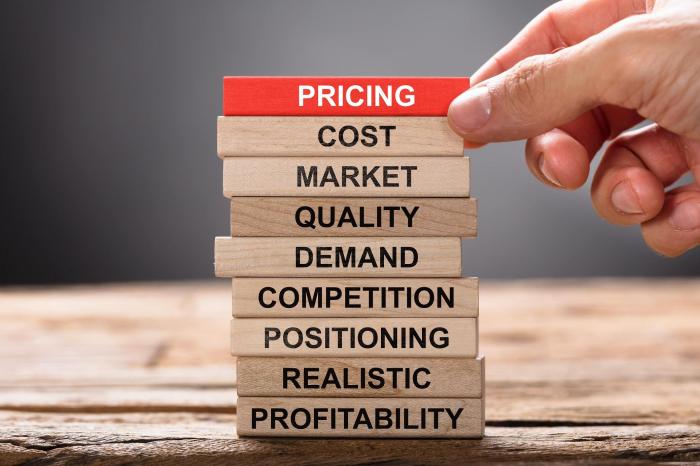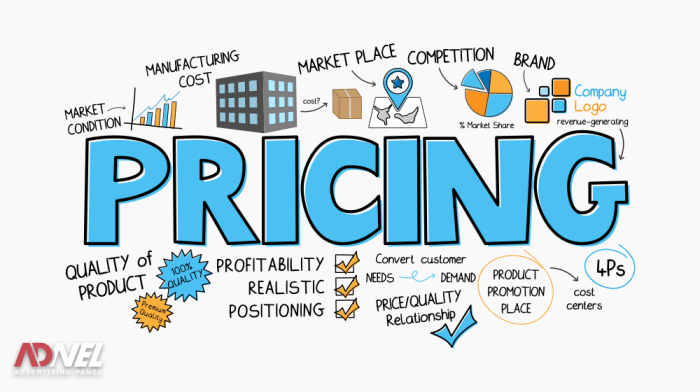Product Pricing Strategies takes center stage, inviting you into a world of business finesse and consumer influence. Get ready to dive deep into the art of pricing products for success.
From setting initial prices to adjusting strategies as products mature, this topic covers it all. Let’s explore the dynamic realm of pricing strategies together.
Introduction to Product Pricing Strategies
Product pricing strategies refer to the methods and techniques used by businesses to set prices for their products or services. These strategies play a crucial role in determining the success and profitability of a company.
Effective pricing strategies are important for businesses as they directly impact revenue, market positioning, and customer perception. By implementing the right pricing strategy, companies can maximize profits, attract target customers, and stay competitive in the market.
Examples of Product Pricing Strategies Impacting Consumer Behavior
- Penetration Pricing: This strategy involves setting a low initial price to attract customers and gain market share quickly. Consumers may be more willing to try a new product or switch brands due to the perceived value.
- Price Skimming: In this strategy, companies set high initial prices to target early adopters and maximize profits before lowering prices to attract more price-sensitive customers. This can create a sense of exclusivity and premium quality in the minds of consumers.
- Psychological Pricing: Pricing products at $9.99 instead of $10.00 can create the illusion of a lower price and influence consumer buying decisions. It plays on the psychological perception of value and affordability.
Types of Product Pricing Strategies
When it comes to product pricing strategies, there are several common approaches that businesses can take to determine the price of their products. Let’s dive into some of the most widely used strategies and explore their advantages and disadvantages.
Cost-Plus Pricing
Cost-plus pricing is a straightforward strategy where a business calculates the total cost of producing a product and then adds a markup to determine the selling price. This markup is typically a percentage of the total cost and serves as the profit margin for the business.
- Advantages:
- Simple and easy to calculate.
- Ensures that all costs are covered and a profit is made.
- Disadvantages:
- Does not take into account customer demand or competitor pricing.
- May result in pricing that is too high or too low compared to the market.
Example: A small bakery uses cost-plus pricing to determine the price of their cakes. They calculate the cost of ingredients, labor, and overhead, then add a 50% markup to set the selling price.
Value-Based Pricing
Value-based pricing involves setting a price based on the perceived value of the product to the customer. This strategy takes into account the benefits and value that the product provides to the customer, rather than just the cost of production.
- Advantages:
- Allows for higher pricing based on the value delivered to the customer.
- Can result in higher profits compared to cost-plus pricing.
- Disadvantages:
- Requires a deep understanding of customer perceptions and willingness to pay.
- Can be difficult to communicate the value proposition to customers.
Example: Apple uses value-based pricing for its products like the iPhone, setting prices based on the perceived value of the brand and the technology offered.
Penetration Pricing
Penetration pricing is a strategy where a business sets a low initial price for a new product to quickly gain market share. The goal is to attract customers with a lower price point and then raise prices once a customer base is established.
- Advantages:
- Helps quickly build a customer base and gain market share.
- Can discourage competitors from entering the market due to low prices.
- Disadvantages:
- May not be sustainable in the long term if prices need to be raised later.
- Customers may perceive the product as low quality due to the low initial price.
Example: Netflix used penetration pricing when it first entered the streaming market, offering a low monthly subscription fee to attract customers away from traditional cable services.
Factors Influencing Product Pricing
When determining product pricing, several key factors come into play that can greatly impact the final pricing decisions. Factors such as competition, target market, and production costs play a crucial role in setting the right price for a product. Additionally, external factors like economic conditions and industry trends can also have a significant influence on pricing strategies. Understanding these factors is essential for businesses to develop effective pricing strategies that resonate with consumers and drive profitability.
Competition, Product Pricing Strategies
Competition is a major factor that influences product pricing decisions. In a competitive market, businesses must consider the prices set by their rivals when determining the price of their own products. Pricing too high above competitors may result in losing customers, while pricing too low may lead to decreased profit margins. Analyzing the pricing strategies of competitors is crucial to finding the right balance and staying competitive in the market.
Target Market
The target market also plays a vital role in product pricing. Different target demographics have varying price sensitivities, purchasing power, and perceived value of products. Understanding the preferences and behaviors of the target market is essential in setting prices that align with their expectations. Businesses must tailor their pricing strategies to cater to the specific needs and preferences of their target audience to maximize sales and profitability.
Production Costs
Production costs are another critical factor that influences product pricing decisions. Businesses need to consider the expenses incurred in manufacturing, packaging, distribution, and other operational costs when setting prices for their products. Pricing below production costs can lead to losses, while pricing too high may deter customers. Finding the right balance between covering production expenses and setting competitive prices is essential for long-term success.
External Factors
External factors such as economic conditions and industry trends can also impact pricing strategies. Fluctuations in the economy, changes in consumer behavior, or shifts in market demand can all influence pricing decisions. Businesses must stay attuned to these external factors and adjust their pricing strategies accordingly to remain competitive and profitable.
Pricing Psychology
Pricing psychology plays a crucial role in determining the perceived value of products. Factors like pricing strategies, discounting techniques, and pricing structure can influence how consumers perceive the value of a product. By leveraging pricing psychology principles, businesses can create pricing strategies that appeal to consumer emotions, motivations, and perceptions, ultimately driving sales and profitability.
Pricing Strategies for New Products

When launching a new product, choosing the right pricing strategy is crucial for its success in the market. It sets the tone for how customers perceive the product and can greatly impact sales and profitability. Here are some common pricing strategies used for new products and tips for setting initial prices in competitive markets.
Penetration Pricing
Penetration pricing is a strategy where the initial price of the product is set lower than competitors’ prices to quickly gain market share. This can help attract price-sensitive customers and create buzz around the new product. However, it may not be sustainable in the long run and may require price adjustments as the product matures in the market.
Price Skimming
Price skimming involves setting a high initial price for the product to target early adopters and customers willing to pay a premium. As demand stabilizes, the price is gradually lowered to attract more price-sensitive customers. This strategy allows the company to maximize profits before facing competition but requires careful monitoring and adjustment as competitors enter the market.
Value-Based Pricing
Value-based pricing focuses on the perceived value of the product to customers rather than solely on costs or competition. This strategy requires a deep understanding of customer needs and preferences to set prices that reflect the product’s value proposition. It allows for flexibility in pricing based on the unique benefits the product offers, making it a strategic choice for new products aiming to stand out in the market.
Tips for Setting Initial Prices
– Conduct market research to understand customer preferences and pricing expectations.
– Consider the costs of production, distribution, and marketing to ensure profitability.
– Evaluate competitors’ pricing strategies and positioning in the market.
– Test different pricing scenarios through surveys or focus groups to gauge customer response.
– Monitor sales data and customer feedback to make timely adjustments to pricing.
Adjusting Pricing Strategies
As new products mature in the market, it is essential to evaluate and adjust pricing strategies to remain competitive and maximize profitability. Factors such as changes in demand, competition, production costs, and customer feedback should be taken into account when revisiting pricing strategies. Regularly assessing and adapting pricing tactics can help sustain the product’s success and ensure long-term growth in the market.
Dynamic Pricing Strategies: Product Pricing Strategies

Dynamic pricing is a strategy where businesses adjust the prices of their products or services in real-time based on various factors such as demand, competition, and even the customer’s willingness to pay. This allows companies to maximize their revenue and profits by setting the right price at the right time.
Benefits of Dynamic Pricing
- Maximizes revenue by capturing the highest price customers are willing to pay
- Helps in staying competitive by adjusting prices in response to market changes
- Improves customer segmentation and targeting by offering personalized pricing
Examples of Industries Using Dynamic Pricing
- Travel and Hospitality: Airlines and hotels often change prices based on demand and booking patterns
- Retail: Online retailers like Amazon adjust prices frequently based on customer behavior and competition
- Ride-sharing Services: Companies like Uber use surge pricing during peak hours or high demand
Challenges and Ethical Considerations
- Price Discrimination: Dynamic pricing can lead to price discrimination where different customers pay different prices for the same product
- Transparency: Customers may feel deceived if they find out they paid more than others for the same product
- Regulatory Concerns: Some jurisdictions have laws against price gouging or unfair pricing practices